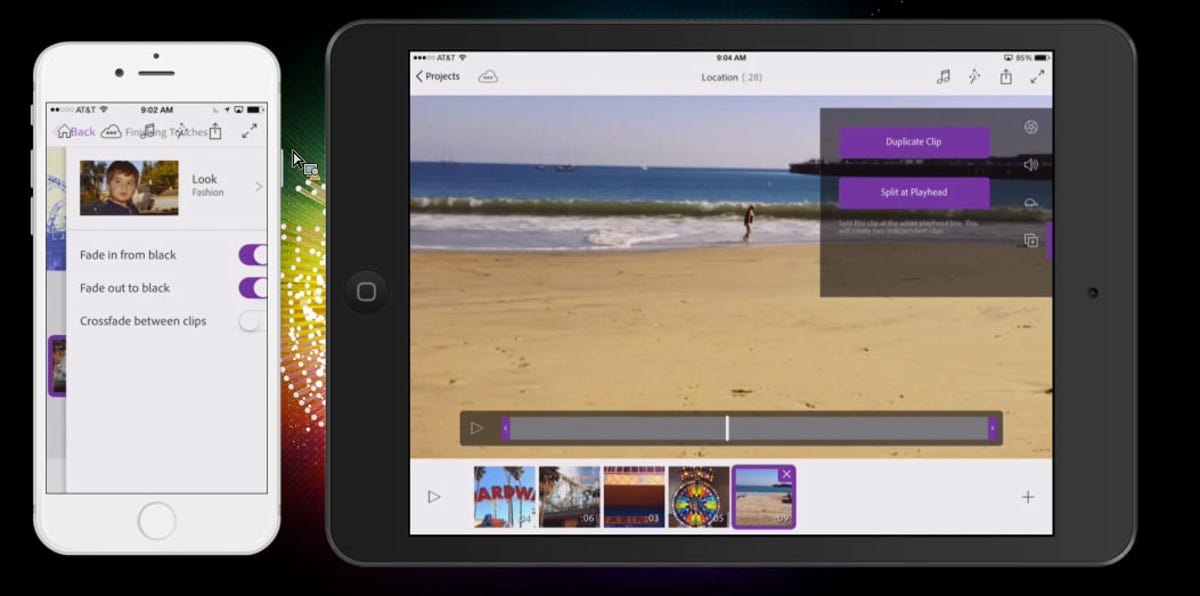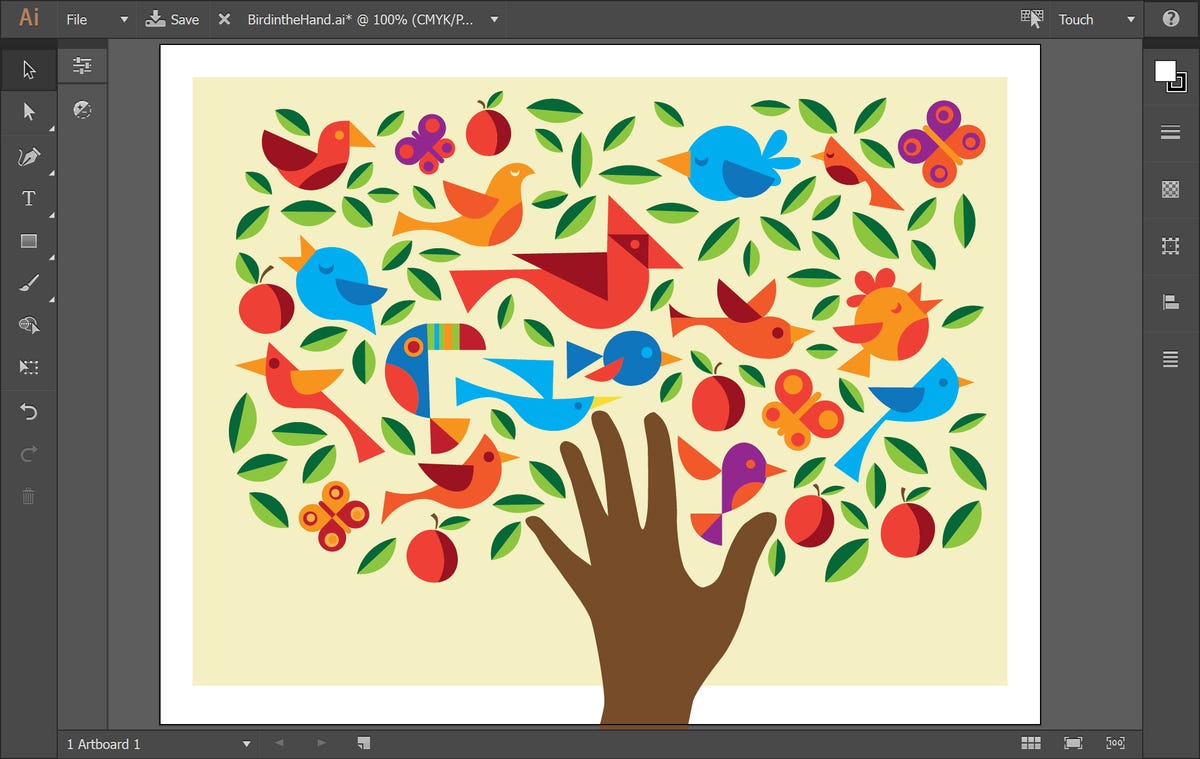
Adobe Systems
Adobe Systems, slow to adapt its creative tools to mobile devices and online services, is starting show it’s no longer so anchored to personal computers.
At its annual Max conference today through Wednesday in Los Angeles, the company plans to show it’s now fighting on all fronts with its tools for designers and other creative types. It will highlight new apps for tablets and smartphones, new services on the Web and new software for its stronghold on PCs as well.
Developments include:
- Updates to mobile apps like Photoshop Mix and three new ones: Brush, Shape and Premiere Clip.
- Touch-screen updates to PC apps, including a new touch-screen mode for the Illustrator graphics-design app and more-subtle, touch-friendly adaptations to Adobe’s video software, Premiere Pro and After Effects.
- A new Creative Profile service that now can synchronize libraries of files, fonts, paintbrushes, photos and color palettes across a range of devices.
- A variety of new feature in core PC apps like Photoshop, InDesign for publishing, and Muse and Dreamweaver for Web publishing.
- An Extract tool that lets people working with Photoshop hand off designs faster and in more complete form to those building Web pages out of those designs.
- The Creative SDK, which exposes Adobe image-handling technology and services so others can use it. Partners include the Snapwire custom photography service, which is using Lightroom editing technology, and Storehouse, an app for publishing photo-rich articles, which can integrate with people’s Lightroom photo catalogs.
These apps and services collectively fall within Adobe’s Creative Cloud, a subscription that embodies the company’s attempt to move beyond the PC era — a transition that’s been tough for the company. Photoshop remains popular among designers and other pros, but a swarm of mobile apps such as Instagram, Snapseed and VSCO Cam have shown that the company’s PC-industry clout doesn’t automatically extend to mobile devices. And the Flash Player software Adobe used to gain influence among online developers and publishers is now well on its way to being the relic that Apple co-founder Steve Jobs declared it to be in 2010.
The Creative Cloud change is working for Adobe and its customers, who now benefit from frequent product updates, said FBR Capital Markets analyst Samad Samana. In the earlier Creative Suite era, updates came every 18 months to 24 months.
“We believe Creative Cloud and the transition to a subscription-based model has proven to be successful,” Samana said. “It has resulted in a higher level of recurring revenue, a stickier customer base, attracted new customers to the Adobe franchise, and reduced the company’s reliance on specific product cycles.”
Adobe has run into a lot of resistance trying to get customers to shift from perpetually licensed software that runs forever once you buy it to a subscription that means Photoshop, Illustrator, Premiere Pro, After Effects and other programs stop working when you stop paying. Despite that resistance, Adobe has reached 2.8 million subscribers since it launched its subscription plan in mid-2012. For comparison, Adobe said in 2013 that it had an installed base of 8.4 million customers using Creative Suite software collections and 4.4 million using individual products.


Stephen Shankland/CNET
Adobe’s Creative Cloud subscription comes in various options. A $10-per-month plan is available for photographers who want Photoshop and Lightroom. Paying $50 per month grants access to Adobe’s full suite of software.
At its Max conference, Adobe will tries to fire up its customers’ enthusiasm, get their creative juices flowing and convince them that Adobe’s technology is worth paying for. Here are some of the developments in more detail.
Premiere Clip and other mobile apps
Adobe is fitting its mobile apps under four new umbrella brands, some carried over from its desktop presence: Photoshop, Illustrator, Premiere and Creative Cloud Capture. For people who want to edit videos, the new Premiere Clip app lets people combine clips into a single video, trimming video as they go, adding background music, bringing coloring styles based on those from the desktop Speedgrade program, and handing the work off to the Premiere Pro desktop software if desired.
The Illustrator brand absorbs two existing apps: Draw — formerly called Ideas — and Line. Draw is for vector-art illustrations — line art like company logos — and the latter is specifically set up for straight-line constructions like shapes and perspectives.


Adobe Systems
In the Capture category is another new app, Brush, which lets people transform photos taken with a mobile phone into paintbrushes that draw vector art in apps like Illustrator or Draw. Paired with it is Shape, which converts photos into vector objects. The third Capture app, Color, is a new name for the earlier Kuler app to extract color palettes from images. Those objects, color palettes and paintbrushes are synchronized through the Creative Cloud so they can be used in other apps.
Lastly, Photoshop Sketch, Photoshop Mix, and Photoshop Lightroom Mobile get updates. The Mix photo editor that Adobe debuted in June now works on iPhones, not just iPads, and has new abilities to precisely separate subjects from backgrounds. The Sketch tool gets five built-in brushes, and people can add those created in Brush. Lightroom Mobile can now ingest location information — including with earlier photos already imported.
Most of the apps are only available for Apple’s iOS operating system, though Adobe has in the past added equivalents for Google’s Android OS later. On Sunday, Adobe did release a new Creative Cloud app for Android, though only a preview version, to let people view and share files they’ve created with programs like Photoshop and Illustrator. It matches an existing but updated Creative Cloud app for iOS.
Touch support for Illustrator and other PC apps
Photoshop was the first app Adobe adapted for the touch-screen future of PCs that Microsoft has embraced with Windows — much more so than Apple has with OS X. Now Premiere Pro and After Effects have followed suit, with user interfaces that can adapt to touch-screen controls with bigger icons suitable for a jab with a fingertip, not just a higher-precision click with a mouse.
More extensive are the changes to Illustrator, though. It’s got a new “touch workspace” that’s geared specifically for control via multitouch screens, Windows tablets like Microsoft Surface Pro, and pen-like drawing styluses like those from Wacom. The user interface is dramatically simplified compared with ordinary Illustrator.


Adobe Systems
Adobe has been working with Microsoft on the new touch support — no surprise, given that both companies are eager to extend their current desktop power into tablets, too. Adobe said customers should expect more touch-centric changes to its software as a result of the partnership.
More updates have arrived as well. Photoshop can accelerate some new functions by using a graphics chip. After Effects gets better 3D graphics abilities. Premiere Pro works on high-resolution Windows machines and gets better search. And a tool called Extract removes some of the manual labor when designers turn prototypes created in Photoshop into Web pages created with Dreamweaver.
Online services
In olden days, Adobe software was licensed to run on a particular computer. Now, increasingly, it’s set up to work for a particular person, regardless of what computer, phone, tablet, or other device is being used.


Adobe Systems
To that end, Adobe has put together what it’s calling the Creative Profile — an online hub that synchronizes not just files but also other assets that Adobe software can use. Those assets, like color palettes and shapes created with mobile apps, are available wherever a person is logged in.
In short, it’s a bridge beyond the days when a designers would get their work done sitting behind a single computer.
Also woven throughout the Adobe experience is Behance — the creativity-focused social network where artists can showcase their work. People can share and sell their work on Behance and look to the site for inspiration through mobile apps and the Web. And with a new premium service called Creative Talent Search that costs $1,500 per month, recruiters can find talent they like based on the style of people’s work.
It’s no Facebook with more than a billion users, but it’s focused and professional. And it shows Adobe has moved beyond its former days of hawking CD-ROMs to designers.




